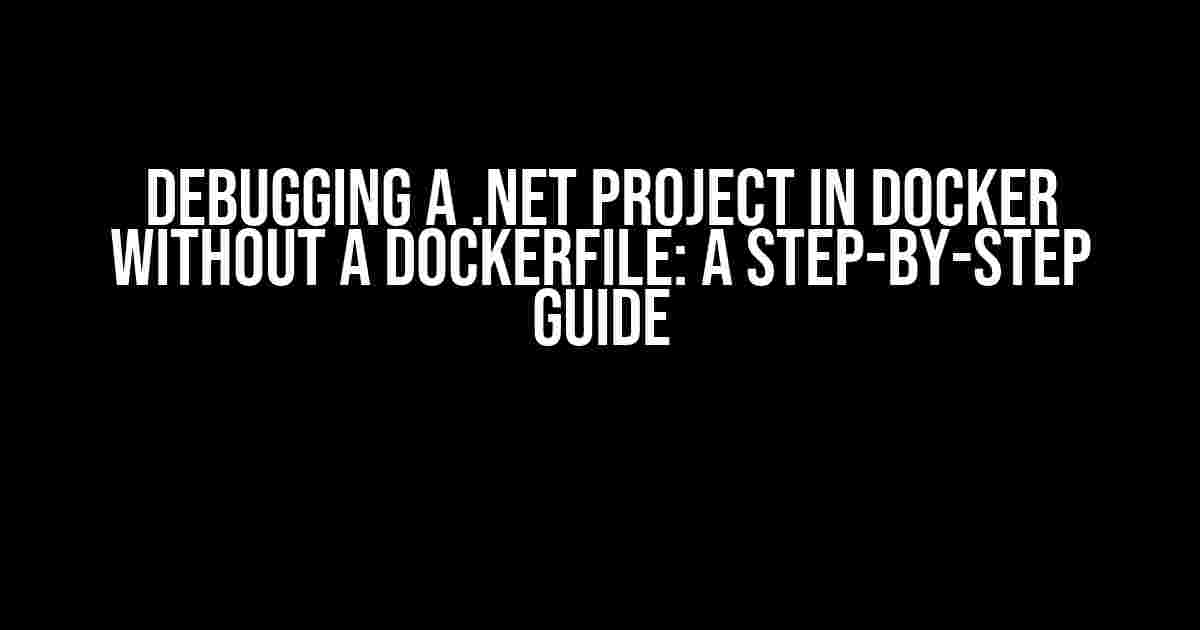Are you tired of dealing with the frustration of debugging a .NET project in Docker without a Dockerfile? You’re not alone! Many developers face this challenge, and it’s time to break down the barriers and get to the bottom of it. In this in-depth article, we’ll walk you through the process of debugging a .NET project in Docker without a Dockerfile, providing you with clear and direct instructions to get you back on track.
The Challenge: Debugging without a Dockerfile
When you’re working on a .NET project in Docker, having a Dockerfile can be a lifesaver. It provides a clear and concise way to build and run your application. However, what happens when you don’t have a Dockerfile? How do you debug your project? This is where things can get tricky, and that’s exactly what we’ll tackle in this article.
Why No Dockerfile?
There are several reasons why you might not have a Dockerfile. Perhaps you’re working on an existing project that wasn’t set up with Docker in mind, or maybe you’re using a third-party library that doesn’t provide a Dockerfile. Whatever the reason, it’s essential to understand that debugging without a Dockerfile requires a different approach.
Step 1: Create a Docker Compose File
To begin debugging your .NET project, you’ll need to create a Docker Compose file. This file will define the services and dependencies required for your application. Create a new file named `docker-compose.yml` in the root of your project directory and add the following code:
version: '3'
services:
app:
build: .
ports:
- "8080:80"
environment:
- ASPNETCORE_ENVIRONMENT=Development
This basic Docker Compose file tells Docker to build the application in the current directory (`.`) and map port 8080 on the host machine to port 80 in the container. We’ve also set the `ASPNETCORE_ENVIRONMENT` variable to `Development` to enable debugging.
Step 2: Configure Visual Studio Code
Next, you’ll need to configure Visual Studio Code (VS Code) to work with Docker. Install the Docker extension for VS Code by following these steps:
- Open VS Code and navigate to the Extensions panel (
Ctrl + Shift + Xon Windows/Linux orCmd + Shift + Xon macOS). - Search for “Docker” in the Extensions Marketplace.
- Click the “Install” button to install the Docker extension.
Once installed, you’ll need to configure the Docker extension to use the Docker Compose file you created earlier. Open the Command Palette in VS Code (Ctrl + Shift + P on Windows/Linux or Cmd + Shift + P on macOS) and type “Docker: Add Docker Compose Configuration”. This will create a new file named `docker-compose.config` in the `.vscode` directory of your project.
Step 3: Add a Debug Configuration
In VS Code, create a new debug configuration by following these steps:
- Open the Run panel in VS Code (
Ctrl + Shift + Don Windows/Linux orCmd + Shift + Don macOS). - Click the “Create a launch.json file” button.
- In the launch.json file, add the following configuration:
{
"version": "0.2.0",
"configurations": [
{
"name": ".NET Core Docker",
"type": "docker",
"request": "launch",
"preLaunchCommand": "docker-compose up -d",
"postDebugCommand": "docker-compose down"
}
]
}
This configuration tells VS Code to use the Docker extension to launch the application using Docker Compose. The `preLaunchCommand` runs `docker-compose up -d` to start the application in detached mode, and the `postDebugCommand` runs `docker-compose down` to stop the application when debugging is complete.
Step 4: Start Debugging
With everything set up, you’re now ready to start debugging your .NET project in Docker. Follow these steps:
- Set a breakpoint in your .NET code where you want to start debugging.
- In the Run panel, select the “.NET Core Docker” configuration.
- Click the “Start Debugging” button (F5 or
Ctrl + F5) to start the debugging process.
VS Code will now attach to the running Docker container and start debugging your application. You can use the debugging tools in VS Code to step through your code, inspect variables, and more.
Troubleshooting Common Issues
Debugging a .NET project in Docker without a Dockerfile can be challenging, and you may encounter some common issues. Here are some troubleshooting tips to help you overcome them:
Issue: Docker Compose Fails to Build the Application
If Docker Compose fails to build your application, check the following:
- Ensure that the `build` context in your `docker-compose.yml` file points to the correct directory.
- Verify that your .NET project is configured to build correctly.
- Check the DockerCompose output for any error messages.
Issue: Debugging Fails to Attach to the Container
If debugging fails to attach to the container, check the following:
- Ensure that the Docker container is running and healthy.
- Verify that the `preLaunchCommand` in your `launch.json` file is correct.
- Check the Docker extension output for any error messages.
Conclusion
Debugging a .NET project in Docker without a Dockerfile can be a daunting task, but with the right tools and configuration, it’s definitely achievable. By following the steps outlined in this article, you should now be able to debug your .NET project in Docker without a Dockerfile. Remember to troubleshoot common issues and don’t be afraid to experiment and try new things. Happy debugging!
| Summary of Steps | |
|---|---|
| Step 1 | Create a Docker Compose file (docker-compose.yml) |
| Step 2 | Configure Visual Studio Code (VS Code) to work with Docker |
| Step 3 | Add a debug configuration (launch.json) |
| Step 4 | Start debugging |
By following these steps, you’ll be well on your way to debugging your .NET project in Docker without a Dockerfile. Remember to stay calm, be patient, and don’t hesitate to ask for help if you need it. Good luck!
Frequently Asked Question
Debugging a .NET project in Docker can be a daunting task, especially when there’s no Dockerfile in sight! Fear not, dear developer, for we’ve got you covered. Below are some frequently asked questions and answers to help you debug your .NET project in Docker without a Dockerfile.
How do I attach a debugger to my .NET process in Docker?
To attach a debugger to your .NET process in Docker, you’ll need to use the `docker exec` command to open a new terminal session inside the container. From there, you can use the `dotnet` command to attach the debugger to the process. For example: `docker exec -it my-container dotnet attach –name my-process-name`.
How can I view the output of my .NET application in Docker?
To view the output of your .NET application in Docker, you can use the `docker logs` command to stream the container’s output to your terminal. For example: `docker logs -f my-container`.
How do I set breakpoints in my .NET code when running in Docker?
To set breakpoints in your .NET code when running in Docker, you’ll need to use a remote debugging tool like Visual Studio or Visual Studio Code. These tools allow you to attach to the .NET process running in the container and set breakpoints as you would normally.
Can I use the Visual Studio debugger to debug my .NET project in Docker?
Yes, you can use the Visual Studio debugger to debug your .NET project in Docker. Simply open your project in Visual Studio, set a breakpoint, and then use the “Debug” > “Attach to Process” menu option to attach to the .NET process running in the container.
What are some common Docker commands I should know when debugging my .NET project?
Some common Docker commands you should know when debugging your .NET project include `docker ps` to list running containers, `docker exec` to open a new terminal session inside a container, and `docker inspect` to inspect the configuration of a container.


